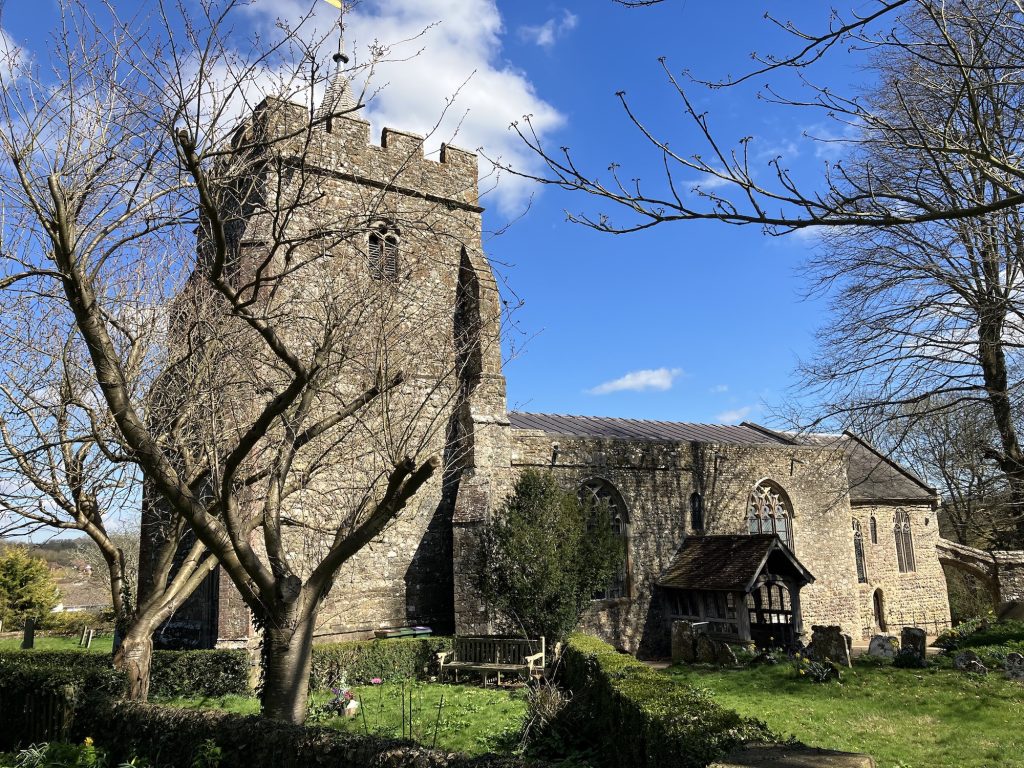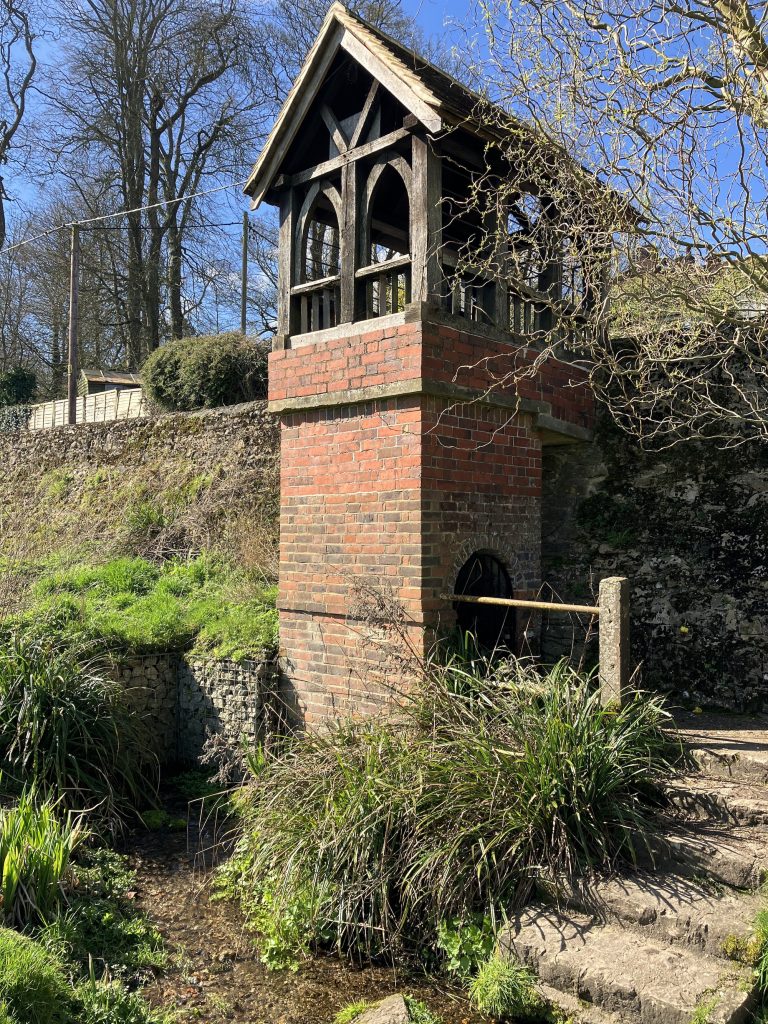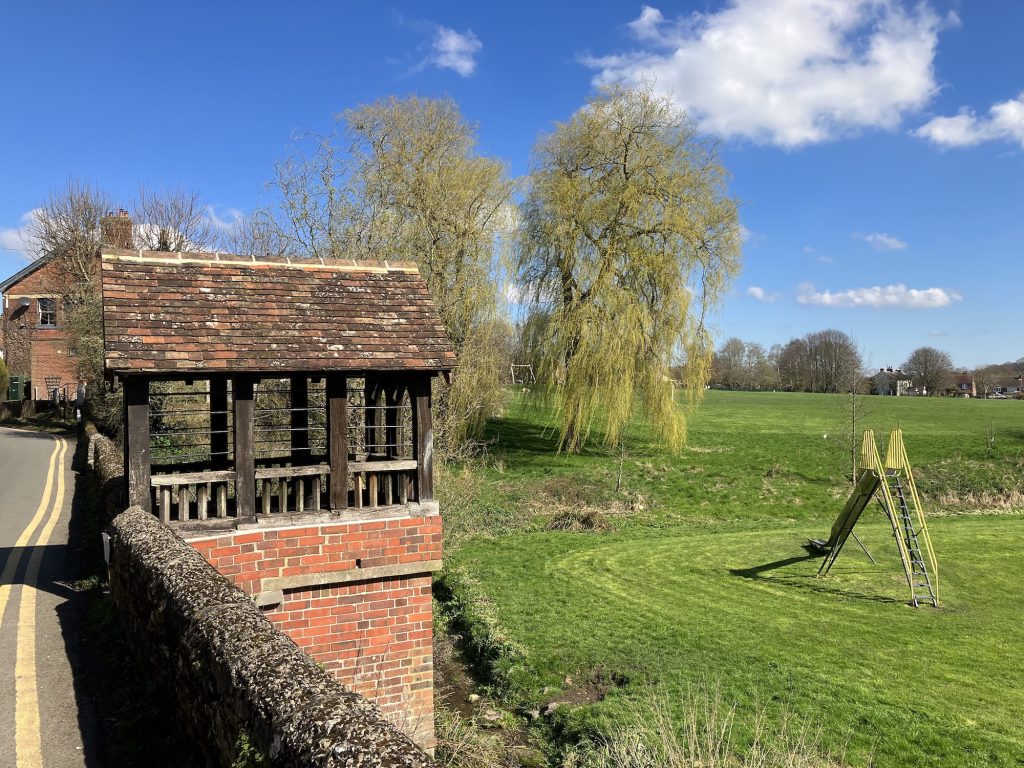In the mid-seventh century, Æthelburh, daughter of Æthelberht, the first Christian king of Kent, established one of England’s earliest Christian communities by the source of a pure chalk stream on the North Downs.
Æthelburh, or Ethelburga as she is now known locally, had been married off to King Edwin of Northumbria but after he was killed in battle (a common fate for Anglo-Saxon kings), she returned home for a life of quiet aristocratic contemplation with God. She commissioned a convent and a small stone church on the hillside directly above the spring feeding the stream in the valley below.
Her good works in the community (and royal connections) were considered sufficient for her to be granted sainthood. The church in the village of Lyminge that bears her name today was built on the same site as Ethelburga’s original structure.

The church of St Mary and St Ethelburga in Lyminge.
More than a century after Ethelburga’s death, another saint with a similar sounding name, Eadburg arrived in Lyminge, or rather her remains did. Eadburg came from Wessex royalty and was an influential abbess at Minster-in-Thanet on the northeast coast of Kent. She is best known for her correspondence with the missionary St Boniface, and promotion of the cult of her mentor St Mildrith.
Eadburg died in 751, and towards the end of the eighth century, her sainted remains were transferred to Lyminge, where the cult of St Eadburg was actively promoted by the church leadership in Canterbury.
The Lyminge Parish Council website notes that:
(St Eadburg’s) feast day of 13 December was added into the liturgical calendar used in Canterbury Cathedral at the end of the 11th Century, indicating that she was recognised as a new and significant saint for the Canterbury community at this time.
The chalk stream spring below the church came to be known as St Eadburg’s Well, and miracles associated with it were recorded in a manuscript of St Eadburg’s life, long forgotten but recently rediscovered in Hereford Cathedral.
The cult of St Eadburg declined in the middle ages and she eventually fell into obscurity. Meanwhile, in the 19th century, a renewed English nationalistic interest in the early Kentish kings, and all things Anglo-Saxon, brought Ethelburga to the fore once again. Interest was heightened further by claims (largely verified today) by Canon Robert Jenkins, the Rector of Lyminge from 1854 to 1896, that he had discovered Ethelburga’s original church and her tomb buried next to the current church.
By this time, the local worthies of the growing village of Lyminge had either completely forgotten about St Eadburg or erroneously assumed her name was just another Anglo-Saxon variant of Ethelburga. They decided that the well, which was the main source of water for the village until 1905 when the mains supply finally arrived, should be named after the better-known St Ethelburga.
The name stuck for more than a century, and it was only three years ago, in 2020, after the Hereford Cathedral manuscript was examined and Eadburg’s life and miracles were revealed, that the parish council voted to restore her name and renovate the dilapidated well for good measure.

St Eadburg’s Well.
However, both saint names are really surplus to requirement. River springs have been worshipped across the globe and throughout human history as a pure, endlessly renewing source of life. In Britain, the ancient Celtic people venerated life-giving springs long before the arrival of Christianity. Springs were widely believed to have healing or transformative powers, resulting in what Christians would later classify as miracles. Peter Ackroyd, in his book Thames: Sacred River, notes that there are at least 26 healing springs located along the Thames, many said to be able to cure blindness and other diseases.
Both the Romans and newly converted Anglo-Saxon Christians followed local tradition and routinely built their temples over existing sacred sites in Britain. A shrine to one of earliest Christian saints of the Thames, Birinus, erected at a spring below Sinodun Hill was believed to cure sick cattle. The Thames, is also linked to numerous female saints, the best known being Frideswide, an Oxford abbess who conjured a healing spring to emerge in the nearby village of Binsey.
Whilst there is no direct evidence of a pre-Christian shrine in Lyminge, there are signs of human habitation in the area dating back some 8,000 years. Archaeological excavations in 2012 revealed masses of flint flakes, detritus from the manufacture of stone tools, showing that the spring was a regular gathering place for nomadic peoples. Farmers began settling in the fertile valley below about 5,000 years ago and remained there right up until the Roman invasion of Britain in the first century, when fortified garrisons and cities became the main centres of population.
Settlers gradually returned to the area after the Romans departed in the fifth century. It is believed that many of the new settlers were former Germanic mercenaries who had been stationed at the Roman fort of Port Lympne some five miles to the south of Lyminge. These settlers called themselves the Limenwara, after the Limen River adjacent to Port Lympne, and the name Lyminge means “the central place of the Limen folk.”
Evidence uncovered on Tayne Field below the church suggests that by sixth and seventh centuries Lyminge had already become a permanent settlement with a substantial manor house often visited by the Kentish kings and their families.

Looking from St Eadburg’s Well across Tayne Field.
It would have made perfect sense to Ethelburga to build her church at a well-established Anglo-Saxon settlement, and on the site of an ancient spring, and later for the Christian establishment in Canterbury to consider that site to be a suitable resting place for the new saint Eadburg.
But as noted above, you really don’t need to append the name of saint, let alone two saints, to a natural river spring to make it sacred. The sacredness of the river should be self-evident.